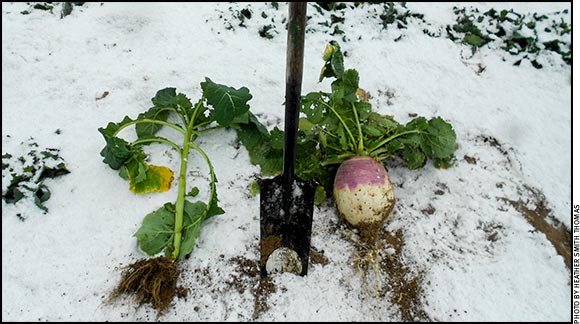
Forage Turnips — A Great Way to Augment Pasture
Forage turnips provide an alternative crop and produce plenty of cattle feed during odd times of the year.
Sometimes non-traditional crops for livestock can augment forage supplies or increase production on a piece of land. Turnips are a good example. Cattle readily eat them and do well on turnips.
Tom Larson of Colorado farmed for many years in Nebraska, managing an organic crop and livestock farm, and experimenting with alternative crops and rotations.
He designed his system with many paddocks and moved cattle every two days.
“All I had was cool-season pasture and no warm-season grasses. To make up for the time in late summer when cool-season plants aren’t growing very well and there are no crop residues yet to utilize, I discovered that the biggest bang for the buck is turnips,” he said.
Larson was one of the first in his area to plant turnips in 1986. Through some research he discovered, in the colonial days, hay had to be cut by hand with a scythe, so farmers turned to sowing turnip seeds in early summer. By fall, the turnips were big enough to feed the cattle.
“Over the years, I’ve planted turnips any time from the first of April until the first of July. I had the best luck when planting them about the first of June. I think they need a little heat for the seed to germinate. The first of May is a little early, and the first of July is getting a little too hot,” says Larson.
In Larson’s experience, one acre of turnips is equivalent to about five acres of grass.
“One year, after harvesting some oats,” he recalls, “I planted turnips. My eight acres of turnips after the oat harvest — planting the turnips a little late — provided feed for 50 animal units (cows, calves and yearlings) for 100 days. That’s a lot of cattle feed!”
The leaves were about 16% protein, similar to alfalfa, and the bulbs about 9% protein. Unlike some other annual forage crops, there were no toxic alkaloids or prussic acid to worry about.
“I never had any problem with choking, and I tried many different varieties, but the plain old purple-top turnips were probably the best.”
The turnips provided adequate nutrients for cattle, but the rumen functions best with a fair amount of roughage, so he put out some old, low-quality round bales. Grass bales or poor-quality alfalfa will work. Larson says the cattle will balance their diet by eating however much roughage they need.
Using several crops on the same acreage can greatly increase output per acre, and cattle spread the necessary fertilizer.
“Their manure can become fairly fluid, and you should maintain a 12-foot distance behind cows, especially if they cough!” he warns.
In Larson’s experience a good crop of turnips will average more than a foot and a half tall. The bulbs will range in size, but should be somewhere between a tennis ball and a softball. The top portion of the bulb is above ground level.
“The cow just puts her muzzle down in a circular motion around the leaves and pushes the turnip sideways with her mouth. The bulb goes into her mouth first and the leaves go in last. The cattle really like those bulbs.”
He found turnips to be a good feed source during times of year forage might be lacking. In Nebraska, Larson’s cool-season pastures would enter a mid-season slump in nutrient levels during the summer heat.
“Cows get tired of eating cardboard. We put them into the green turnips and they loved it. Pivot corners or feedlots that aren’t being used in the summer can grow turnips. They are very good for odd corners and can provide great forage for a few weeks,” says Larson.
“The forage turnips produced more feed for less effort than anything else I did on the farm. The investment was tiny and the returns phenomenal, when you figure what it generally costs per day to feed cattle.”

Editor’s Note: Heather Smith Thomas is a freelance writer and cattlewoman from Salmon, Idaho.






